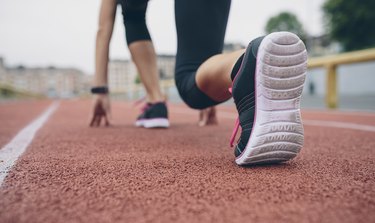
Sprinting uses the same muscles as running, but requires that they are considerably more limber for short bursts of speed while avoiding injury.
Running is powered by the legs, hips and glutes, so training the same muscles with a focus on speed will prepare you for sprinting. While training, avoid raising on your toes or pumping too high with your arms. Allow the primary muscles used for running to provide the power to sprint.
Video of the Day
Video of the Day
The Stronger, the Better
The quadriceps are the muscles at the front of your thighs. These muscles raise the leg and propel the runner forward. Muscles throughout your body work in coordinating pairs. One muscle group pulls in one direction and its coordinating muscle group pulls in the opposite direction.
The quadriceps work in conjunction with the hamstrings as the most important coordinating pair for sprints. The quadriceps pull the legs forward for fast bursts of running. The stronger the quads are, the faster your legs will pull your body forward — and the faster you'll be able to sprint.
Read more: The Best Exercises for Every Major Muscle
Elasticize Your Hamstrings
The hamstrings are the large muscles at the back of the thighs that work with the quadriceps. They pull the leg back so that the sprinter has the force to push off the ground quickly from the calves. Both the quads and hamstrings work at the same time on alternating legs, so sprinting is quickest when each is toned and elastic for speed. The hamstrings are most elastic when the hips and glutes are strong and stabilized.
What Do the Glutes Do?
The glutes, or muscles of the backside, are some of the largest muscles in your body, says Brian Mac Sports Coach. Sprinters use them to assist in propulsion and to support the work of the quadriceps and hamstrings.
When sprinting, you may find that the glutes work less than the legs. This could be due to glutes that have become long and weak from sitting too much. Engage the muscles of the backside in order to avoid injury to the legs; and invest some time into doing exercises for your glutes such as the bridge, back leg lifts, lunges and squats.
Nimble Hip Flexors
The hip flexors are a group of muscles that surround the hips and work with the glutes, quads and hamstrings. These muscles are often overlooked, but are crucial to sprinters, because nimble hip flexors allow your legs to move quickly and in concert with the rest of your body's speed of propulsion. Stretching the hip flexors, in particular — ExRx.net suggests trying the standing hip flexor stretch — is important to maintaining speed throughout your sprint without injury.
Read more: List of Muscular Endurance Exercises
Vital to Sprinting
The calves comprise two muscles: gastrocnemius and soleus, says Michigan Medicine. Some anatomists consider these as one muscle group called the triceps surae. These muscles are vital to sprinting more than regular running, because the muscles of the calves control foot flexion when running. Sprinters should be prepared to spring off the next foot during each stride before impact to minimize time on the ground. Strong, elastic calves support the additional speed of a sprint.
Stretch Your Muscles
Developing elasticity is the main difference between training to run long distances and training to sprint. Over time, your body naturally accommodates the style in which you train it. If you are training to run generally, your body may not have the elasticity it requires to sprint competitively. ACE Fitness reports that flexibility training is often neglected. So regular stretching of the muscles most important to sprinting will keep your body moving quickly at all stages of each stride.